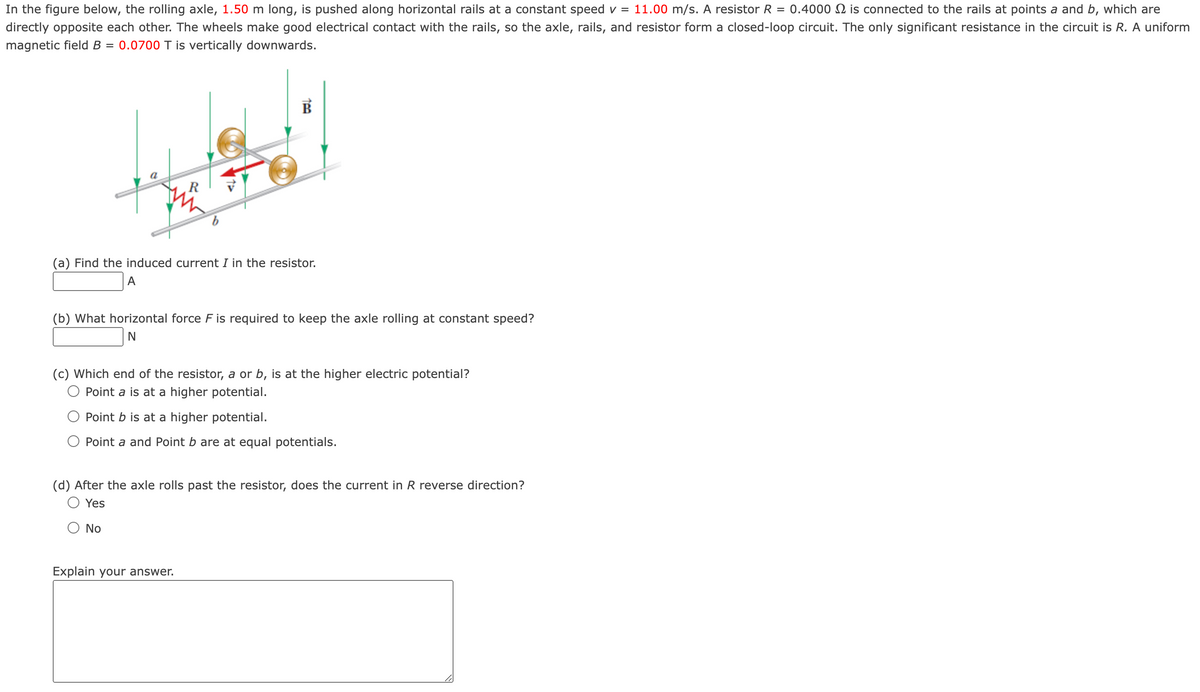In the figure below, the rolling axle, 1.50 m long, is pushed along horizontal rails at a constant speed v= 11.00 m/s. A resistor R = 0.4000 2 is connected to the rails at points a and b, which are directly opposite each other. The wheels make good electrical contact with the rails, so the axle, rails, and resistor form a closed-loop circuit. The only significant resistance in the circuit is R. A unifo magnetic field B = 0.0700 T is vertically downwards. (a) Find the induced current I in the resistor. A (b) What horizontal force F is required to keep the axle rolling at constant speed? N (c) Which end of the resistor, a or b, is at the higher electric potential? O Point a is at a higher potential. O Point b is at a higher potential. O Point a and Point b are at equal potentials. (d) After the axle rolls past the resistor, does the current in R reverse direction? O Yes O No Explain your answer.
In the figure below, the rolling axle, 1.50 m long, is pushed along horizontal rails at a constant speed v= 11.00 m/s. A resistor R = 0.4000 2 is connected to the rails at points a and b, which are directly opposite each other. The wheels make good electrical contact with the rails, so the axle, rails, and resistor form a closed-loop circuit. The only significant resistance in the circuit is R. A unifo magnetic field B = 0.0700 T is vertically downwards. (a) Find the induced current I in the resistor. A (b) What horizontal force F is required to keep the axle rolling at constant speed? N (c) Which end of the resistor, a or b, is at the higher electric potential? O Point a is at a higher potential. O Point b is at a higher potential. O Point a and Point b are at equal potentials. (d) After the axle rolls past the resistor, does the current in R reverse direction? O Yes O No Explain your answer.
Physics for Scientists and Engineers with Modern Physics
10th Edition
ISBN:9781337553292
Author:Raymond A. Serway, John W. Jewett
Publisher:Raymond A. Serway, John W. Jewett
Chapter30: Faraday's Law
Section: Chapter Questions
Problem 42AP: Review. In Figure P30.42, a uniform magnetic field decreases at a constant rate dB/dt = K, where K...
Related questions
Question

Transcribed Image Text:=
In the figure below, the rolling axle, 1.50 m long, is pushed along horizontal rails at a constant speed v = 11.00 m/s. A resistor R 0.4000 2 is connected to the rails at points a and b, which are
directly opposite each other. The wheels make good electrical contact with the rails, so the axle, rails, and resistor form a closed-loop circuit. The only significant resistance in the circuit is R. A uniform
magnetic field B = 0.0700 T is vertically downwards.
100
(a) Find the induced current I in the resistor.
A
(b) What horizontal force F is required to keep the axle rolling at constant speed?
N
(c) Which end of the resistor, a or b, is at the higher electric potential?
O Point a is at a higher potential.
Point b is at a higher potential.
Point a and Point b are at equal potentials.
(d) After the axle rolls past the resistor, does the current in R reverse direction?
Yes
No
Explain your answer.
Expert Solution
This question has been solved!
Explore an expertly crafted, step-by-step solution for a thorough understanding of key concepts.
This is a popular solution!
Trending now
This is a popular solution!
Step by step
Solved in 4 steps with 3 images

Knowledge Booster
Learn more about
Need a deep-dive on the concept behind this application? Look no further. Learn more about this topic, physics and related others by exploring similar questions and additional content below.Recommended textbooks for you

Physics for Scientists and Engineers with Modern …
Physics
ISBN:
9781337553292
Author:
Raymond A. Serway, John W. Jewett
Publisher:
Cengage Learning

Physics for Scientists and Engineers
Physics
ISBN:
9781337553278
Author:
Raymond A. Serway, John W. Jewett
Publisher:
Cengage Learning

College Physics
Physics
ISBN:
9781285737027
Author:
Raymond A. Serway, Chris Vuille
Publisher:
Cengage Learning

Physics for Scientists and Engineers with Modern …
Physics
ISBN:
9781337553292
Author:
Raymond A. Serway, John W. Jewett
Publisher:
Cengage Learning

Physics for Scientists and Engineers
Physics
ISBN:
9781337553278
Author:
Raymond A. Serway, John W. Jewett
Publisher:
Cengage Learning

College Physics
Physics
ISBN:
9781285737027
Author:
Raymond A. Serway, Chris Vuille
Publisher:
Cengage Learning

College Physics
Physics
ISBN:
9781305952300
Author:
Raymond A. Serway, Chris Vuille
Publisher:
Cengage Learning

Principles of Physics: A Calculus-Based Text
Physics
ISBN:
9781133104261
Author:
Raymond A. Serway, John W. Jewett
Publisher:
Cengage Learning

Physics for Scientists and Engineers, Technology …
Physics
ISBN:
9781305116399
Author:
Raymond A. Serway, John W. Jewett
Publisher:
Cengage Learning